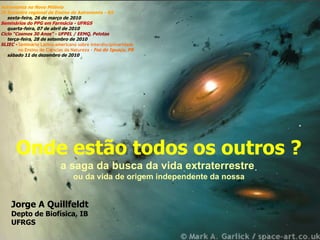
Onde estão todos os outros?
- 1. Astronomia no Novo Milênio IV Encontro regional de Ensino de Astronomia - RS sexta-feira, 26 de março de 2010 Seminários do PPG em Farmácia - UFRGS quarta-feira, 07 de abril de 2010 Ciclo “Cosmos 30 Anos” - UFPEL / EEMQ, Pelotas terça-feira, 28 de setembro de 2010 SLIEC - Seminário Latino-americano sobre Interdisciplinaridade no Ensino de Ciências da Natureza - Foz do Iguaçu, PR sábado 11 de dezembro de 2010 Onde estão todos os outros ? a saga da busca da vida extraterrestre ou da vida de origem independente da nossa Jorge A Quillfeldt Depto de Biofísica, IB UFRGS
- 2. (pop.III) Cosmic MwBg (3K): http://planck.cf.ac.uk/
- 5. Os Três primeiros minutos... Nucleossíntese primária do “Big Bang”
- 7. 100 a 300s depois... segue a Nucleossíntese do “Big Bang”
- 8. Ora, direis, ouvir estrelas...
- 10. Fusão Nuclear nas estrelas: queima do H Cadeia próton-próton (estrelas frias) Ciclo CNO (estrelas quentes)
- 11. Primeiras estrelas... Nucleossíntese Estelar
- 12. Fusão Nuclear nas estrelas: queima do He queima do C queima do Ne queima do O queima do Si + pesados?...Captura de n o (processo s) Processo triplo alfa (temperatura >100MK, st velhas c/ [He] )
- 18. Eta carinae releasing matter
- 22. Reflection nebula NGC 1999 illuminated by V380 Orionis
- 23. NASA online: [1] PeteSF 23:28, 22 February 2007
- 25. The ISM Star-forming regions in M16
- 27. Discos Protoplanetários em NGC 3603 (Brandner, Grebel, Chu, Dottori, Brandl, Richling, York, Points y Zinnecker AJ,2000)
- 29. Figure 11 The cycle of organic molecules in the Universe. Interstellar organics are formed in the interstellar gas, in stellar outflows and on dust grains. This organic material is integrated in the Solar System and is partly chemically processed and/or destroyed. In the final stage of stars, dust and elements are returned to the interstellar medium. Organic molecules formed during this dust cycle may have seeded the early Earth. Ehrenfreund & Charnley, 2000 Annu.Rev.Astron.Astrophys. 38 :427–83
- 35. S.J.Gould, Sci Am Oct.1994 Unicelulares Multicelulares Animais ? ?
- 38. OK, temos vida na terra... ... mas e noutras partes?
- 43. Três impulsos recentes à Exobiologia: Nichos habitáveis no sistema solar (Marte, Europa, Titã, Vênus, etc) Descoberta de Exoplanetas ... >90 (ago2002) >100 (dez2003 & 17/03/2004) + primeira foto direta (29mai2005) 181 planetas / 147 sistemas (08/03/2006) 215 planetas / 175 sistemas (05/03/2007) 228 planetas / ~200 sistemas (05/03/2008) 342 planetas / 270+ sistemas (05/03/2009) 442 planetas / 351 sistemas (25/03/2010) 490 planetas / 388 sistemas (27/09/2010) 506 planetas / 397 sistemas (09/12/2010) Descoberta das Extremófilas Exobiologia fase III 1 2 3
- 44. Jack Corliss, 1977, Galápagos, 9‘N, 2600m
- 49. Os 5 Reinos Os 3 Domínios da Vida (C.Woese)
- 50. Stetter, 1998 (IN: Brack, 1998)
- 57. Terra 97% água nos oceanos 2% nas capas de gelo + lagos, rios e lençóis (e também vapor atmosférico)
- 59. Mars Pathfinder (EUA, 1997)
- 60. Albee, Sci Am june 2003
- 62. ?
- 63. Mars Odissey 2001 X 1 22mai2002
- 66. Mars Global Surveyor MOC Pólo Norte (EUA, 1997-2004)
- 67. 2 18jan2004
- 69. ESA Mars Express 2003 1 a detecção direta de água (congelada) por IV no Pólo S 18jan2004 OMEGA observed the southern polar cap of Mars on 18 January 2004, as seen on all three bands. The right one represents the visi- ble image, the middle one the CO2 (carbon dioxide) ice and the left one the H2O (water) ice.
- 70. Opportunity - 12fev2004 3 12fev2004
- 71. Opportunity Rover Finds Strong Evidence Meridiani Planum Was Wet 02mar2004
- 72. mar2004
- 73. mar2004
- 74. 4 25mai2008
- 75. Mars Reconaissance Orbiter (MRO) Devon Island (Canada)
- 83. Titã
- 84. Encelado
- 87. Tritão
- 89. Sonda Giotto a 600 Km do Cometa Halley 14mar1986
- 90. Sonda Deep Impact (Cometa Tempel-1) 08jul2005
- 94. 3/4 das águas trazidas por cometas ?
- 95. CONCLUSÕES: * Água líquida no Sistema Solar: somente na Terra (por ora...) * Água Congelada no Sistema Solar: também em Marte Europa Calisto Titã Encelado Cometas
- 100. 0.25 0.3 Gliese 581 Tidal Lock Radius Gliese 581c
- 101. Quais as melhores Bioimpressões para a procura de vida extraterrestre?
- 103. The Herschel Space Observatory has revealed the chemical fingerprints of potentially life-enabling organic molecules in the Orion nebula . The new data, obtained with the telescope's heterodyne instrument for the far infrared -- one of Herschel's three innovative instruments -- demonstrates the gold mine of information that Herschel will provide on how organic molecules form in space. http://www.astrobiology.com/news/viewpr.html?pid=30360 ESA , March 7, 2010
- 104. Darwin
- 105. 29 abr 2005
- 106. “ Man is the matter of the cosmos, contemplating itself.” Carl Sagan, 1973 “ The Cosmic Connection”
